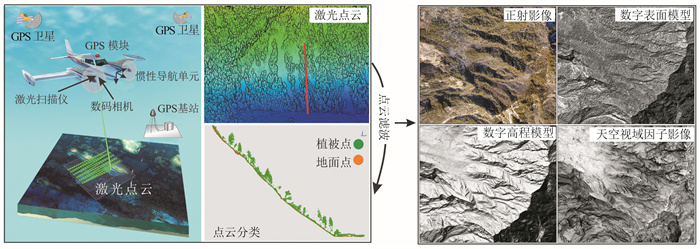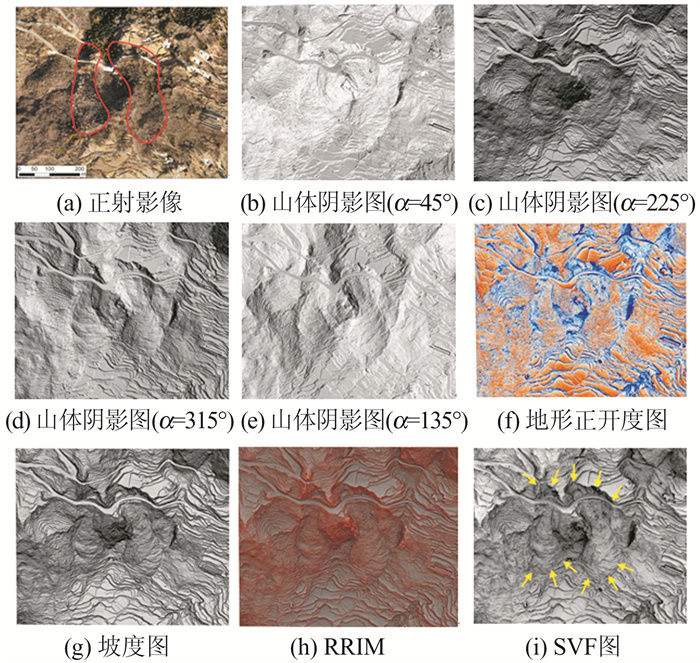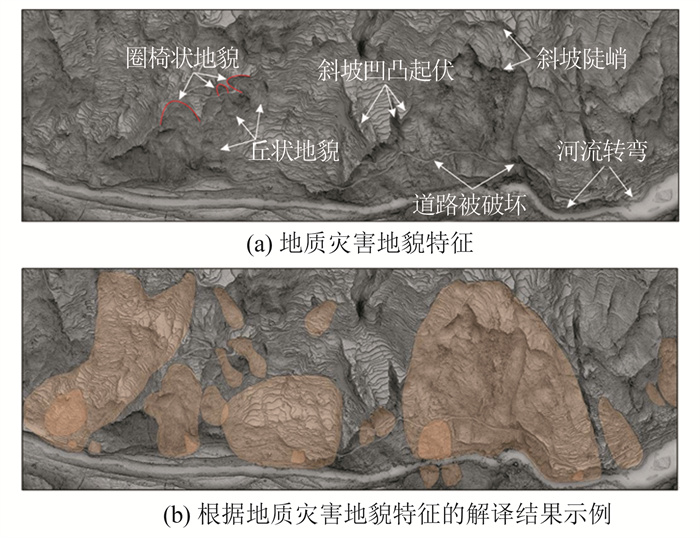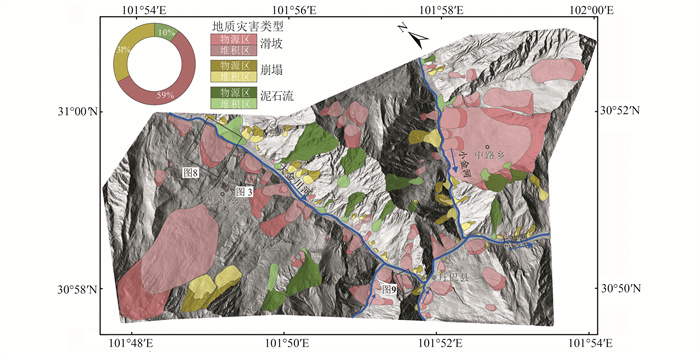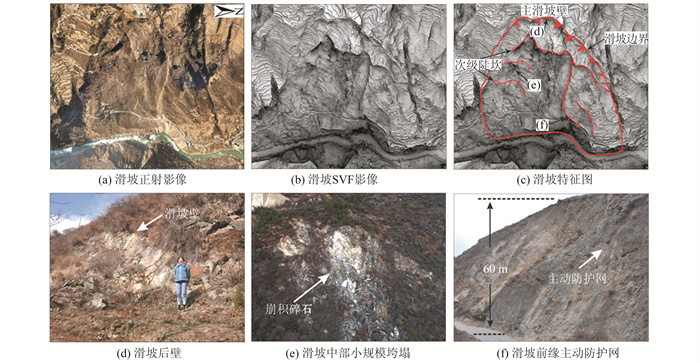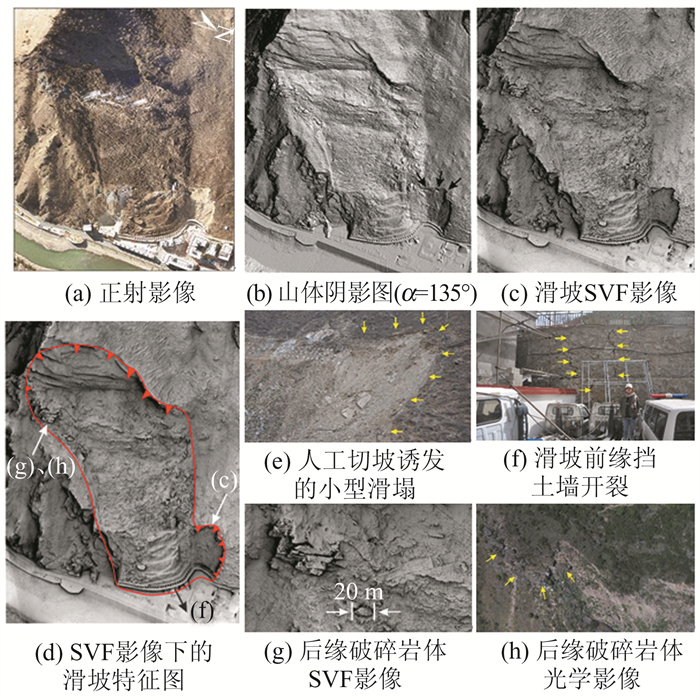-
摘要: 地质灾害识别是灾害易发性评价以及监测预警的基础,采用传统的人工地面调查和卫星遥感方式在地形条件复杂的高植被覆盖山区进行地质灾害识别具有较大困难。机载激光雷达技术(light detection and ranging, LiDAR)的发展为高植被复杂山区的地质灾害识别提供了新的解决方案。利用获取的机载LiDAR点云数据,通过点云滤波、空间插值生成了高分辨率数字高程模型(digital elevation model, DEM),结合天空视域因子(sky view factor,SVF)的DEM可视化方法,开展了中国四川省丹巴县城周边135 km2的地质灾害识别研究工作。共解译出地质灾害146处,总面积约46.48 km2,占研究区总面积的33.4%,并通过现场实地调查验证了机载LiDAR识别结果的可靠性。在此基础上分析了该区地质灾害的空间分布规律及其影响因素。研究结果为高植被复杂山区的地质灾害识别提供了一定参考,并为丹巴县地质灾害防治与风险评价提供数据支撑。Abstract:Objectives Geohazard recognition and inventory mapping are the basis for geohazard susceptibility mapping, monitoring and early warning.However, it has been challenging to implement geohazard recognition and inventory mapping in mountainous areas with complex topography and vegetation cover though manual field survey or satellite remote sensing.Progress in the light detection and ranging(LiDAR) technology provides a new possibility for geohazard recognition in such areas.Methods A high-resolution digital elevation model (DEM) was generated through the LiDAR point filtering and spatial interpolation, and combined with the DEM visualization method of sky view factor(SVF). Subsequently, the geohazard recognition work of Danba County and its surrounding area with a total area of 135 km2 was carried out.Results A total of 146 geohazards are remotely mapped and classified as slides, rock fall, debris flows based on morphologic characteristics, it shows nearly one-third of the study area is dominated by geohazards. Field validation indicate the success rate of LiDAR-derived DEM in recognition and mapping landslides with higher precision and accuracy. On the basis of this, the spatial distribution characteristics and influencing factors of the geohazards were analyzed and it indicate these mapped geohazards lie along both sides of the river, and their spatial distributions are related highly to human engineering activities, such as road excavation and slope cutting.Conclusions The research results provide references for geohazard recognition and mapping in mountainous areas with complex topography and vegetation cover and provide data support for the geohazard prevention and risk assessment for Danba county.
-
-
-
[1] Santangelo M, Cardinali M, Rossi M, et al. Remote Landslide Mapping Using a Laser Rangefinder Binocular and GPS[J]. Natural Hazards and Earth System Sciences, 2010, 10(12): 2 539-2 546 doi: 10.5194/nhess-10-2539-2010
[2] Nichol J, Wong M S. Detection and Interpretation of Landslides Using Satellite Images[J]. Land Degradation and Development, 2005, 16(3): 243-255 doi: 10.1002/ldr.648
[3] 李为乐, 许强, 陆会燕, 等. 大型岩质滑坡形变历史回溯及其启示[J]. 武汉大学学报·信息科学版, 2019, 44(7): 1 043-1 053 doi: 10.13203/j.whugis20190090 Li Weile, Xu Qiang, Lu Huiyan, et al. Tracking the Deformation History of Large-Scale Rocky Landslides and Its Enlightenment[J]. Geomatics and Information Science of Wuhan University, 2019, 44 (7): 1 043-1 053 doi: 10.13203/j.whugis20190090
[4] Dong J, Zhang L, Tang M, et al. Mapping Landslide Surface Displacements with Time Series SAR Interferometry by Combining Persistent and Distributed Scatterers: A Case Study of Jiaju Landslide in Danba, China[J]. Remote Sensing of Environment, 2018, 205: 180-198 doi: 10.1016/j.rse.2017.11.022
[5] Schlögel R, Doubre C, Malet J P, et al. Landslide Deformation Monitoring with ALOS/PALSAR Imagery: A D-InSAR Geomorphological Interpretation Method[J]. Geomorphology, 2015, 231: 314-330 doi: 10.1016/j.geomorph.2014.11.031
[6] Intrieri E, Raspini F, Fumagalli A, et al. The Maoxian Landslide as Seen from Space: Detecting Precursors of Failure with Sentinel-1 Data[J]. Landslides, 2018, 15(1): 123-133 doi: 10.1007/s10346-017-0915-7
[7] Gorum T, Fan X, van Westen C J, et al. Distribution Pattern of Earthquake-Induced Landslides Triggered by the 12 May 2008 Wenchuan Earthquake [J]. Geomorphology, 2011, 133(3/4): 152-167 http://www.onacademic.com/detail/journal_1000035387115210_cb3f.html
[8] Rossi G, Tanteri L, Tofani V, et al. Multitemporal UAV Surveys for Landslide Mapping and Characterization[J]. Landslides, 2018, 15(5): 1 045-1 052 doi: 10.1007/s10346-018-0978-0
[9] Fiorucci F, Cardinali M, Carlà R, et al. Seasonal Landslide Mapping and Estimation of Landslide Mobilization Rates Using Aerial and Satellite Images [J]. Geomorphology, 2011, 129(1): 59-70 http://www.onacademic.com/detail/journal_1000035386678010_2fe5.html
[10] Yamazaki F, Kubo K, Tanabe R, et al. Damage Assessment and 3D Modeling by UAV Flights After the 2016 Kumamoto, Japan Earthquake[C]//IEEE International Geoscience and Remote Sensing Sym posium, Fort Worth, USA, 2017
[11] Tomás R, Li Z. Earth Observations for Geohazards: Present and Future Challenges[J]. Remote Sensing, 2017, 9(3): 194 doi: 10.3390/rs9030194
[12] Fan X, Xu Q, Alonso-Rodriguez A, et al. Successive Landsliding and Damming of the Jinsha River in Eastern Tibet, China: Prime Investigation, Early Warning, and Emergency Response[J]. Landslides, 2019, 16(5): 1 003-1 020 doi: 10.1007/s10346-019-01159-x
[13] Fan X, Xu Q, Scaringi G, et al. Failure Mechanism and Kinematics of the Deadly June 24th 2017 Xinmo Landslide, Maoxian, Sichuan, China[J]. Landslides, 2017, 14(6): 2 129-2 146 doi: 10.1007/s10346-017-0907-7
[14] Roering J J, Mackey B H, Marshall J A, et al. "You Are HERE": Connecting the Dots with Airborne LiDAR for Geomorphic Fieldwork[J]. Geomorphology, 2013, 200: 172-183 doi: 10.1016/j.geomorph.2013.04.009
[15] McKean J, Roering J. Objective Landslide Detection and Surface Morphology Mapping Using High-Resolution Airborne Laser Altimetry[J]. Geomorphology, 2004, 57(3/4): 331-351 http://www.researchgate.net/profile/Josh_Roering/publication/222398914_McKean_J.__Roering_J._Objective_landslide_detection_and_surface_morphology_mapping_using_high-resolution_airborne_laser_altimetry._Geomorphology_57_331-351/links/09e41511bec79b1738000000.pdf
[16] Guzzetti F, Mondini A C, Cardinali M, et al. Landslide Inventory Maps: New Tools for an Old Problem [J]. Earth-Science Reviews, 2012, 112(1/2): 42-66 http://194.119.218.4/publications/repository/public/journals/2012/landslide-inventory-maps-new-tools-for-and-old-problem/@@download/file/Guzzetti-etal-LandslideInventoryMaps-NewToolsForOldProblem-ESR-2012.pdf
[17] Chigira M, Duan F, Yagi H, et al. Using an Airborne Laser Scanner for the Identification of Shallow Landslides and Susceptibility Assessment in an Area of Ignimbrite Overlain by Permeable Pyroclastics [J]. Landslides, 2004, 1(3): 203-209 doi: 10.1007/s10346-004-0029-x
[18] Comert R, Avdan U, Gorum T, et al. Mapping of Shallow Landslides with Object-Based Image Analysis from Unmanned Aerial Vehicle Data[J]. Engineering Geology, 2019, 260(July): 105264 http://www.sciencedirect.com/science/article/pii/S0013795219302261
[19] Chen R F, Chang K J, Angelier J, et al. Topographical Changes Revealed by High-Resolution Airborne LiDAR Data: The 1999 Tsaoling Landslide Induced by the Chi-Chi Earthquake[J]. Engineering Geology, 2006, 88(3/4): 160-172 http://140.112.114.62/bitstream/246246/85123/1/8.pdf
[20] Ardizzone F, Cardinali M, Galli M, et al. Identification and Mapping of Recent Rainfall-Induced Landslides Using Elevation Data Collected by Airborne Lidar[J]. Natural Hazards and Earth System Science, 2007, 7(6): 637-650 doi: 10.5194/nhess-7-637-2007
[21] Jaboyedoff M, Oppikofer T, Abellán A, et al. Use of LiDAR in Landslide Investigations: A Review [J]. Natural Hazards, 2012, 61(1): 5-28 doi: 10.1007/s11069-010-9634-2
[22] Bell R, Petschko H, Röhrs M, et al. Assessment of Landslide Age, Landslide Persistence and Human Impact Using Airborne Laser Scanning Digital Terrain Models[J]. Geografiska Annaler, Series A: Physical Geography, 2012, 94(1): 135-156 doi: 10.1111/j.1468-0459.2012.00454.x
[23] Li X, Cheng X, Chen W, et al. Identification of Forested Landslides Using LiDAR Data, Object-Based Image Analysis, and Machine Learning Algorithms[J]. Remote Sensing, 2015, 7(8): 9 705-9 726 doi: 10.3390/rs70809705
[24] 董秀军, 许强, 佘金星, 等. 九寨沟核心景区多源遥感数据地质灾害解译初探[J]. 武汉大学学报·信息科学版, 2020, 45(3): 432-441 doi: 10.13203/j.whugis20190076 Dong Xiujun, Xu Qiang, She Jinxing, et al. Preliminary Study on Interpretation of Geological Hazards in Jiuzhaigou Based on Multi-source Remote Sensing Data[J]. Geomatics and Information Science of Wuhan University, 2020, 45(3): 432-441 doi: 10.13203/j.whugis20190076
[25] 王绚, 范宣梅, 杨帆, 等. 植被茂密山区地质灾害遥感解译方法研究[J]. 武汉大学学报·信息科学版, 2020, 45(11): 1 771-1 781 doi: 10.13203/j.whugis20200044 Wang Xuan, Fan Xuanmei, Yang Fan, et al. Remote Sensing Interpretation Method of Geological Hazards in Lush Mountainous Area[J]. Geomatics and Information Science of Wuhan University, 2020, 45(11): 1 771-1 781 doi: 10.13203/j.whugis20200044
[26] 李明辉, 郑万模, 石胜伟, 等. 丹巴县甲居滑坡复活机制及其稳定性分析[J]. 山地学报, 2008, 26(5): 577-582 doi: 10.3969/j.issn.1008-2786.2008.05.011 Li Minghui, Zheng Wanmo, Shi Shengwei, et al. The Revival Mechanism and Stability Analysis to Jiaju Landslide of Danba County in Sichuan Province [J]. Journal of Mountain Science, 2008, 26(5): 577-582 doi: 10.3969/j.issn.1008-2786.2008.05.011
[27] Chen N S, Li T C, Gao Y C. A Great Disastrous Debris Flow on 11 July 2003 in Shuikazi Valley, Danba County, Western Sichuan, China[J]. Landslides, 2005, 2(1): 71-74 doi: 10.1007/s10346-004-0041-1
[28] 范宣梅, 许强, 黄润秋, 等. 丹巴县城后山滑坡锚固动态优化设计和信息化施工[J]. 岩石力学与工程学报, 2007, 26(S2): 4 139-4 146 https://www.cnki.com.cn/Article/CJFDTOTAL-YSLX2007S2080.htm Fan Xuanmei, Xu Qiang, Huang Runqiu, et al. Dynamical Optimal Anchoring Design and Information Construction of Danba Landslide[J]. Chinese Journal of Rock Mechanics and Engineering, 2007, 26 (S2): 4 139-4 146 https://www.cnki.com.cn/Article/CJFDTOTAL-YSLX2007S2080.htm
[29] Huang R. Some Catastrophic Landslides Since the Twentieth Century in the Southwest of China[J]. Landslides, 2009, 6(1): 69-81 doi: 10.1007/s10346-009-0142-y
[30] Chiba T, Kaneta S, Suzuki Y. Red Relief Image Map: New Visualization Method for Three Dimensional Data[J]. The International Archives of the Photogrammetry, Remote Sensing and Spatial Information Sciences, 2008, 37(B2): 1 071-1 076 http://pdfs.semanticscholar.org/2d08/f3a9722fd63e57c48214c02575c69fd6129f.pdf
[31] Conrad O, Bechtel B, Bock M, et al. System for Automated Geoscientific Analyses (SAGA) v. 2. 1. 4 [J]. Geoscientific Model Development, 2015, 8(7): 1 991-2 007 doi: 10.5194/gmd-8-1991-2015
[32] 晏长根, 祁生文, 伍法权, 等. 大渡河猴子岩水电站库尾段藏碉群斜坡巨型堆积体的成因分析[J]. 工程地质学报, 2006, 14(2): 159-164 https://www.cnki.com.cn/Article/CJFDTOTAL-GCDZ200602002.htm Yan Changgen, Qi Shengwen, Wu Faquan, et al. Investigation of the Formation of Huge Quaternary Deposition Dadu River Near Houziyan Hydropower Dam[J]. Jounal of Engineering Geology, 2006, 14 (2): 159-164 https://www.cnki.com.cn/Article/CJFDTOTAL-GCDZ200602002.htm
[33] Görüm T. Landslide Recognition and Mapping in a Mixed Forest Environment from Airborne LiDAR Data[J]. Engineering Geology, 2019, 258: 105-155 http://www.sciencedirect.com/science/article/pii/S0013795219303539
-
期刊类型引用(3)
1. 周永章,陈川,张旗,王功文,肖凡,沈文杰,卞静,王亚,杨威,焦守涛,刘艳鹏,韩枫. 地质大数据分析的若干工具与应用. 大地构造与成矿学. 2020(02): 173-182 .  百度学术
百度学术
2. 王叶晨梓,杜震洪,张丰,刘仁义. 面向分片地图的多分辨率格点数据统一存取方法. 浙江大学学报(理学版). 2017(05): 584-590 .  百度学术
百度学术
3. 朱建章,石强,陈凤娥,史晓丹,董泽民,秦前清. 遥感大数据研究现状与发展趋势. 中国图象图形学报. 2016(11): 1425-1439 .  百度学术
百度学术
其他类型引用(6)





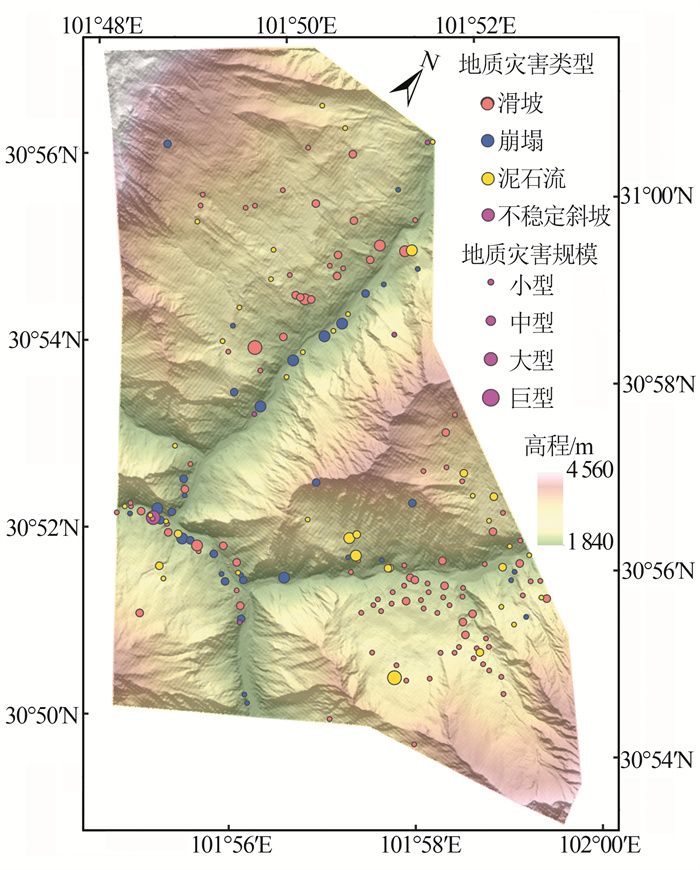
 下载:
下载:
